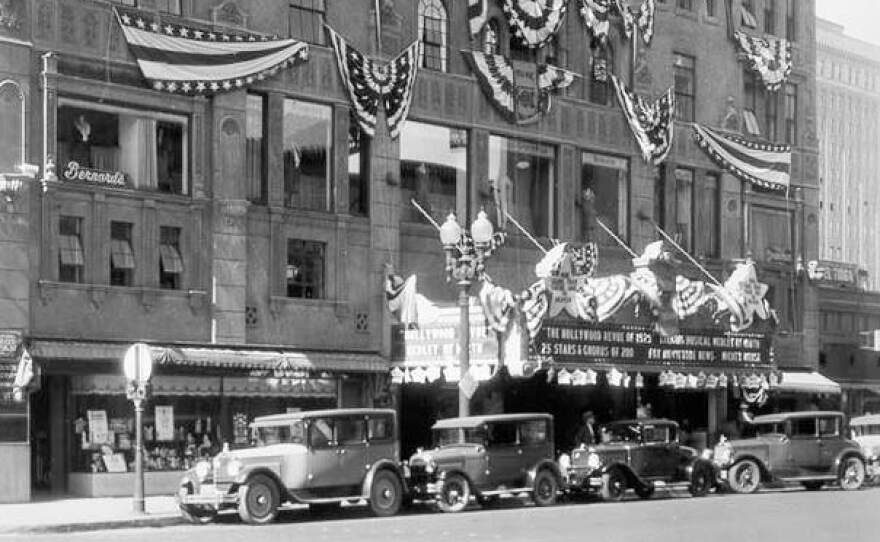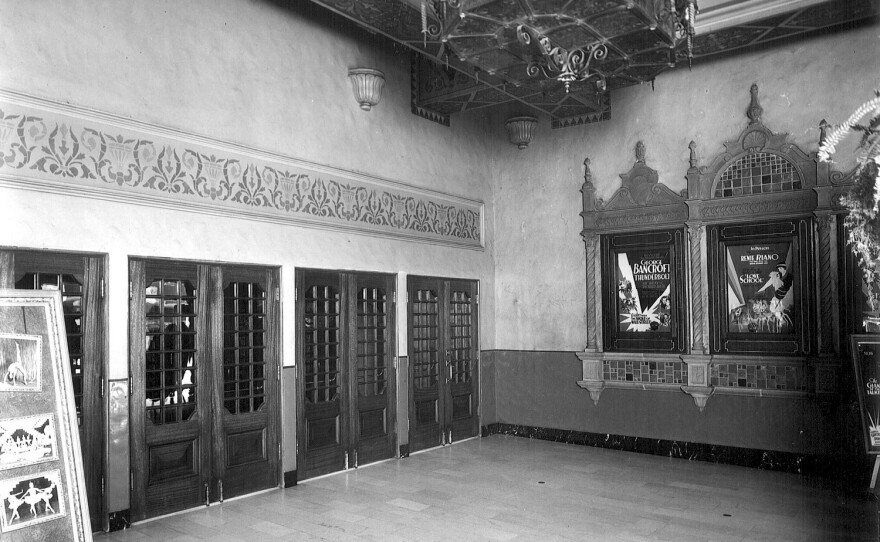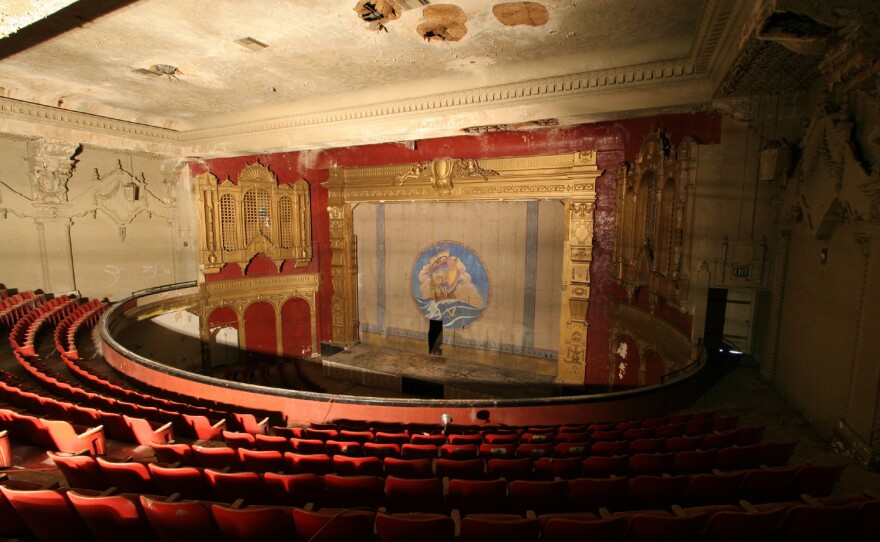A couple of years ago, it was dangerous to walk by the abandoned California Theatre on 4th and C Streets. The cool vintage marquee reading “California” was falling down and posed a threat to passersby. It was rightfully taken down, robbing the building of one of its last remaining jewels (tarnished as it was).
The theater is on the ground floor of a shuttered nine-story building. The property covers an entire city block and has sat empty for more than 20 years. Vagrants and pigeons live inside. Graffiti dots its walls, including a piece by the French street artist Invader.
Few people have been inside since it was boarded up. It’s an unlikely fate for a building so prominently located on a prime piece of real estate. The California Theatre building sits directly across the street from City Hall.
In 2011, I wrote about a vintage advertisement on the side of the theater building. The city had approved a proposal to paint over the sign with a beer advertisement. A public outcry and lobbying by historic preservationists resulted in the city reversing its decision. The vintage sign was saved, but the building its on seems far from salvation.
It’s currently for sale, though that’s not unusual. The current owners, Sloan Capital LLC, periodically list the 81,000 square foot building and entertain offers. They acquired it through foreclosure. The building is also historically designated and is on the local Register of Historical Resources. This limits what can be done with it.
A lot of developers have shown interest in the building over the years, but none have been able to rescue it from a decades-long limbo. Its ruined state has contributed to the overall blight along one of San Diego’s most powerful downtown corridors.
The Past: From Cathedral to Rotting Shell

Movie theaters were once called movie palaces. When the California Theatre opened in 1927, it was so ornate it was called “the cathedral of the motion picture.” A silent, black-and-white film called “The Venus of Venice” screened on opening night.


It was a large venue with 2,200 seats, a curved balcony, and a single screen (multiplexes were unheard of at that time). Its Art Deco marquee read “California.” The building housed restaurants and a high-end department store.
The California had a long run as a movie theater. Bruce Coons, executive director of the Save our Heritage Organization, saw a Beatles concert film there in the 1960s. “The girls screamed so much we couldn’t hear anything,” Coons recalled.
Toward the end of the 1970s, the theater space was used for special events, including concerts.
Patti Smith recorded an album there in 1978. The poet and novelist Jim Carroll, famous for penning “The Basketball Diaries,” opened for her.
San Diegan Rex Edhlund saw one of the best shows of his life there. The punk band Public Image Ltd. came to town in 1984. The lead singer was former Sex Pistols frontman Johnny Rotten, whom Edhlund describes as the “Lincoln of punk rock.”
At one point during the concert, Edhlund rushed the stage and Johnny Rotten handed him his beer. On-stage bouncers tossed Edhlund into the crowd but he managed to save the prized beer.
Edhlund said by that time, the theater was a rotting shell. “It smelled like a place everyone there had broken into. It had this tattered fabric, and everything you’d expect from a punk rock show.”
Eventually the building’s owners foreclosed and investors took over the lease. The building was shuttered and has been left to decay since 1990.
The Present: A Black Hole





A chain link fence surrounds the building in an attempt to keep squatters out, though some suspect people have found ways to get in.
If that’s true, squatters and vagrants are among the few who’ve been inside over the last few decades.
David Marshall is an architect who specializes in historic buildings. Five years ago, he went inside the theater when his firm, Heritage Architecture and Planning, was hired by an interested developer to assess damage to the theater and building.
What he saw was disheartening.
The theater suffered the most damage. It was full of trash and mildew. The roof has numerous holes so rainwater had caused a lot of damage. “There were dead rodents and pigeons,” Marshall said. There was more than a foot of standing water in the basement.
Marshall worked on the 2008 restoration of the Balboa Theatre just blocks away. That project cost $26 million. He says the California Theatre is in worse shape and is much larger. He thinks renovating it will cost between $30 and $40 million.
Abandoned buildings are not unusual in urban areas. The irony here is this derelict building's proximity to City Hall. “There it is, immediately next door,” explained Marshall. “Probably visible out the window of the movers and shakers in the city and there it’s sat for many years, just an eyesore.”
And it’s not just the theater. C Street has become a blighted downtown corridor. When the trolley line was added, it became difficult for cars to access the street. That drove retail and restaurants away.
“It’s a black hole,” said Gary London, a local real estate economist. He thinks the rundown theater has had a psychic toll on the area. “It has a tremendous effect. It sucks all the energy out of that central business district,” added London.
The Future: A Way Out of Limbo?
Developers have been interested in buying the California Theatre building over the years, but the high price tag is a problem. It’s listed at $10.3 million dollars. Some estimates put its actual worth at $3 million.
The building is also protected as a historic site, which limits what can be done with it.
Bruce Coons and the Save Our Heritage Organization lobbied successfully to get the building’s historic protection. He would like to see the whole building renovated and the theater restored. Coons suspects the owner is keeping the price high so the building continues to fall apart. “He has some fantasy that he can bulldoze it, which isn’t going to happen,” Coons insisted.
The realtor for Sloan Capital, Cyrus Rapinan of Rosano Partners, admitted the owners are not in a rush to sell the building, even though they get offers “all the time.” Rapinan said the listing price is based on what the land would be valued at in a healthy market, and they need to get a return on their investment.
But will that return come from a renovated theater? London doesn’t think that makes economic sense. “There are probably a lot of other theaters that are underutilized where millions of dollars have been spent renovating them,” London said. “The Balboa and the Spreckels Theatre are probably empty most of the time.”
Redevelopment funds, which no longer exist, were used to renovate the Balboa Theatre in 2008. It’s still operating at a loss.
But there are those who look at the building and still see a theater.
Dawn Griffin, CEO of Davenport Financial Group, is one of them. She is a developer looking for investors. Griffin wants to buy the California Theatre building and turn it into a high-end theater and performing arts academy. She explained: “If we needed more condos, great, but we don’t. If we needed more offices, fine, but we don’t. But do we need an excellent state of the art theater? I think we do.”
That remains to be seen.
One thing we know for sure, San Diego does NOT need a historically protected pile of rubble.






